Journalist Report – April 12th
Journalist report for the 12 april 2025
Author: Batoul Tani
Today’s operations were marked by a successful EVA, carried out despite strong winds and slightly reduced visibility. The crew proceeded cautiously and managed to explore the region as planned. Additionally, the team used a geological hammer to investigate the terrain and search for potential fossil remains, adding a valuable scientific component to the excursion.
In the Science Dome, Batoul, our Crew Journalist, reached an important step in her microbiological work. Her first sets of bacterial cultures have now completed their treatment phase. She closely monitored the samples throughout the process and will obtain her first results tomorrow, which will help evaluate bacterial survival under simulated Martian conditions.
Bérengère, our GreenHab Officer, dedicated time to plant care and environmental control in the greenhouse. Despite the intense heat inside the GreenHab during the hottest part of the day, she was able to tend to the crops and ensure optimal conditions for plant growth.
For the rest of the crew, the day was relatively calm in terms of experimental activity, with most projects requiring only routine monitoring. Daily tasks were carried out as scheduled, ensuring continuity of data collection and system maintenance. We took advantage of the bad weather to shoot videos for our social media.
Sadly, as the sky was cloudy and the winds were too strong, we didn’t make any observations with the musk observatory.
Overall, the day unfolded smoothly, balancing field exploration and laboratory work, and setting the stage for new results in the coming days.
Operations Report – April 12th
Crew 314 Operations Report 12-04-2025
SOL: 6
Name of person filing report: Antoine Dubois (Engineer)
Non-nominal systems :
The tunnels have been checked.
Notes on non-nominal systems :
Tunnels: We carried out a complete check of the tunnels due to the wind speed and 11 cable ties have been replaced. The 100 pack of cable ties (11 inch) is empty.
ROVERS
Spirit rover used: /
Hours: (before EVA)/
Beginning charge: (Before EVA) /
Ending charge: (On return from EVA, before recharging) /
Currently charging: yes
Opportunity rover used: Not used
Hours: /
Beginning charge: /
Ending charge: /
Currently charging: yes
Curiosity rover used: EVA#8
Hours: 307.6
Beginning charge:100
Ending charge: 59
Currently charging: No
Perseverance rover used: EVA#8
Hours: 318.7
Beginning charge: 100
Ending charge: 58
Currently charging: No
General notes on rovers: Has Opportunity been checked out regarding the battery ? It seemed to lower quickly during our previous EVAs as mentioned yesterday in our report.
Summary of Hab operations : Today in the Hab, we dedicated time to cooking, socializing, making progress on our experiments and advancing our individual reports. We also did some physical exercise to maintain our shape. In addition, we filmed a few videos for our social media channels. To wrap up the day, we held our regular team meeting to review our progress and plan the tasks ahead.
Water Use (please use both methods to estimate water usage)
Time of measurements (collect data for the same time window): 7 p.m.
1) Per formula (see notes): 13.20 gallons
2) Smart Home Dashboard (see notes): 17.30 gallons
Water (static tank, remaining gallons): 344.02 gallons (per formula) & 355.68 gallons (Smart Home Dashboard)
Static tank pipe heater (on or off): off
Static tank heater (on or off) : off
Toilet tank emptied (no or yes): no
Summary of internet: Research for experiments, languages learning and music listening
Summary of suits and radios:
Suits EVA#8 : 7, 8, 9 and 10
Radios EVA #8 : 3, 4, 6 and 7
Summary of GreenHab operations: put notes here:
I watered all the plants with water in which I added 2 teaspoons of Miracle-Gro (I finished one small bag) per 2 gallons of water.
The door of the GreenHab was left open for 7 hours 50 minutes (11.10 am to 7 pm) to reduce the temperature inside (maximum of 102.7 °F).
I watered and checked the seeds of the 3 small rectangular black pots (sprouts of China Rose radish) with the new cultures (Kale, Arugula and cress). The seeds of sprouts of China Rose radish (which were in water to initiate germination) were sown in a small rectangular black pot and I added a label.
I removed plants in the square blue pot because they were at the end of their life.
I cleaned the floor of the GreenHab.
WATER USE: 8.75 gallons
Heater (On or Off): Heater on (setup temperature = 72°F)
Supplemental light (hours of operation): 7-10 pm
Harvest (name, weight in grams): 1 rainbow cherries and 1 spring onion
Summary of ScienceDome operations: put notes here
Check the condition of plantain seedlings and watering
Check Petri dishes for arbuscular fungi spore germination
Shooting videos explaining our experiments for our social networks
Isolation of AMF spores
Inoculation of Esherichia coli
Inoculation on petri dishes of Bacillus Thuringiensis with soils
Treatment of treated dishes
Dual split (Heat or AC, On or Off): Off
Summary of RAM operations:
At 9:20 a.m., the Crew Engineer took 2 zip ties and a dark ribbon to repair equipment in the field if needed. However, no repair was necessary, and all materials were returned to their place.
We shot some videos explaining our experiments for our belgian social network during the afternoon.
At 7:10 p.m., we took 11 cable ties in the RAM to fix the tunnel.
Summary of any observatory issues: None, weather conditions were not good enough, too many clouds and strong winds making it unsafe.
Summary of health and safety issues: Everyone was in good health today, with no issues reported. There were no safety concerns to note.
Questions, concerns and requests to Mission Support:
A request was submitted to Mission Support to assist the crew in closing the main entrance door, which had suddenly slammed open due to strong winds and became stuck. Thanks to Mission Support’s prompt intervention, the issue was successfully resolved.
Can we have a new pack of 11 inch cable ties ? The package was emptied during the tunnel check.
Since some of the canned goods and food supplies (such as eggs, coffee, etc.) were already partially used upon our arrival, would it be possible to receive a resupply?
EVA Report – April 12th
Crew 314 EVA Report 12-04-2025
EVA # 8
Author: Bérengère Bastogne (Greenhab Officer)
Purpose of EVA: We will head to the Sea of Shells where we will conduct a drone exploration and use the hammer to search for fossils. On the return journey, we will also stop at the intersection of Galileo Road and Cow Dung Road to inspect Antoine’s equipment.
At those two stops, the crew will stay within 1 mile from the rovers.
Destination: The furthest point of the EVA will be the Sea of Shells. We will then head back at the MDRS to make a second stop at the intersection of Galileo and Cow Dung Road.
Start time: 9:30am
End time: 11:32am
Narrative:
Today’s EVA was carried out under hotter weather conditions compared to previous sols and some wind (around 15mph wind gusts). The crew departed the Hab at 09:44 with two rovers, heading toward the Sea Shells region to continue geological sampling.
At 09:52, the team passed Cowboy Corner and reached the intersection with Brahe Highway at approximately 10:00. At that point, the communication signal was extremely weak, and the team was unable to establish contact with CapCom.
By 10:10, the EVA team arrived at the Sea Shells site. Although the signal improved briefly, the area’s terrain quickly descended, resulting in another loss of signal. The team proceeded with their sampling task despite this challenge.
At 10:27, wind conditions were recorded: gusts reaching 16 mph with a steady wind of 4 mph coming from the west. The crew completed their work and began the return to the rovers at 10:56, but they were not able to fly the drone given the high winds.
They reached Brahe Highway again at 11:01, where communication was re-established. By 11:07, they returned to Cow Dung Road. A driver switch took place: Odile and Béa took over for the next leg of the journey.
The crew arrived at the site of Antoine’s experiment at 11:16 to perform a brief inspection. After a short stop, they returned to the rovers at 11:20 and switched drivers once again, this time Louis and Béa taking the wheel.
The EVA concluded with the rovers returning to the MDRS at 11:24. Decompression procedures were initiated immediately upon arrival and completed by 11:32.
This EVA allowed for critical fieldwork in multiple locations despite some signal challenges. The efficient management of time and logistics ensured the mission goals were achieved safely and effectively.
Destination: The furthest point of the EVA will be the Sea of Shells. We will then head back at the MDRS to make a second stop at the intersection of Galileo and Cow Dung Road.
Coordinates (use UTM WGS 84):
First stop : Sea of Shells (4255500N,516500W)
Second stop : Intersection Galileo Road and Cow Dung Road (4252250N, 519000W)
Participants: Antoine Dubois (Engineer), Béatrice Hollander (Commander), Odile Hilgers (HSO), Louis Baltus (Astronomer)
Road(s) and routes per MDRS Map: The EVA will begin on Moonwalk Road, then proceed along Cow Dung Road 0110. From there, we will follow Brahe Highway to the Overlook, and then take Copernicus 1575 Highway to reach the Sea of Shells. For the return trip to the MDRS, we will retrace the same route in reverse.
Mode of travel: Driving and walking
GreenHab Report – April 12th
Crew 314 GreenHab Report 12-04-2025
GreenHab Officer: Bérengère Bastogne
Environmental control (fan & heater):
Heater on (setup temperature = 72 °F)
Fan on (to keep the temperature below 94 °F)
Average temperatures (last 24h): 87.7 °F
Maximum temperature (last 24h): 102.7 °F
Minimum temperature (last 24h): 72.7 °F
Hours of supplemental light: 7-10 pm
Daily water usage for crops: 8.5 gallons
Daily water usage for research and/or other purposes: 0.25
Water in Blue Tank (200 gallon capacity): 144.85 gallons
Time(s) of watering for crops: 20 min
Changes to crops: The seeds of sprouts of China Rose radish (which were in water to initiate germination) were sown in a small rectangular black pot and I added a label.
I removed plants in the square blue pot because they were at the end of their life.
Narrative: I watered all the plants with water in which I added 2 teaspoons of Miracle-Gro (I finished one small bag) per 2 gallons of water.
The door of the GreenHab was left open for 7 hours 50 minutes (11.10 am to 7 pm) to reduce the temperature inside (maximum of 102.7 °F).
I watered and checked the seeds of the 3 small rectangular black pots (sprouts of China Rose radish) with the new cultures (Kale, Arugula and cress). The seeds of sprouts of China Rose radish (which were in water to initiate germination) were sown in a small rectangular black pot and I added a label.
I removed plants in the square blue pot because they were at the end of their life.
I cleaned the floor of the GreenHab.
Harvest: (include which crop and mass in grams) 12 rainbow cherries and 1 spring onion
Support/supplies needed: None
Crew Photos – April 11th
Journalist Report – April 11th
Journalist report 11 Apr 2025
Author: Batoul Tani
Today marked another productive sol for the crew at the Mars Desert Research Station (MDRS), as we continued to advance our scientific objectives under simulated Martian conditions.
Early in the day, a scheduled EVA was carried out under relatively high temperatures. The mission had two primary goals: to collect soil samples from the designated Special Region for Bérengère’s GreenHab experiment, and to inspect and maintain the external equipment for Antoine’s ongoing engineering project. Despite the heat and communication challenges encountered during the EVA, both objectives were successfully accomplished, and the team returned safely to the Hab on schedule.
Bérengère continued her role as GreenHab Officer by planting a new set of fast-germinating crops, like radish sprouts, arugula, cress, and other leafy greens, to monitor early growth patterns in a controlled Martian analog environment. She also continued regular maintenance activities, including watering and development tracking of existing plants.
Meanwhile, Antoine focused on retrieving meteorological data from his external sensor array. This data is vital for assessing environmental variability and ensuring operational safety, particularly in preparation for future EVAs. His engineering experiment also includes long-term monitoring of equipment performance under field conditions similar to those on Mars.
In the Science Dome, Batoul, our crew journalist and science communicator, dedicated the afternoon to creating a new experiment simulating the effects of Martian microgravity.
Throughout the day, our daily scientific protocols continued without disruption. Each crew member follows a rigorous schedule, contributing to a wide range of interdisciplinary experiments that reflect the collaborative and multi-faceted nature of analog missions.
After a productive and challenging day, the crew came together for a group workout session to unwind and relieve the physical and mental tension that had built up throughout the day. It was a moment of camaraderie and relaxation, providing the team with a much-needed break after a day filled with intense tasks and valuable experiences.
Sol Summary – April 2025
Crew 314 Sol Summary Report 11-04-2025
Sol: 5
Summary Title: Life Between Red Dust and Blue Skies
Author’s name: Arnaud de Wergifosse (Crew executive officer)
Mission Status: ongoing
Sol Activity Summary: Early in the day, an EVA was carried out to collect soil samples for Bérengère’s GreenHab experiment and to check on the equipment for Antoine’s ongoing engineering project. Both tasks were completed successfully, despite the hot conditions outside.
Back in the station, Bérengère planted new seeds in the GreenHab: radish sprouts, arugula, cress, and other fast-growing greens. She also took time to water the existing plants and monitor their development.
Meanwhile, Antoine downloaded the meteorological data, crucial for tracking environmental changes and ensuring the safety of future EVAs.
Batoul, our journalist, spent the afternoon programming a new experiment which simulates the effects of Martian microgravity.
Our daily scientific protocols continue steadily, as each team member follows their assigned experiment schedules with precision and focus.
Life at the MDRS is a constant balance between routine and the unexpected, and today was a perfect example of that.
Look Ahead Plan: One EVA is scheduled in the morning to conduct Antoine’s experiment. Throughout the day, we will continue working on our individual experiments. Béatrice and Arnaud will carry on their research while collecting data with their wearables and with a questionnaire about stress and sleep evaluation. Louis will continue his work in the Observatory.
Anomalies in work: None was notified.
Weather: Sunny without clouds in the morning and the afternoon. Temperatures varied between 44°F and 90°F for the lowest and highest temperatures of the day.
Crew Physical Status: Everyone was in good health today, with no issues reported.
EVA: The EVA team exited the Hab at 09:31 after a 5-minute decompression. Batoul and Odile took Curiosity, while Bérengère and Antoine drove Opportunity. The team passed Cowboy Corner and arrived at the Special Region by 10:05, where they collected two soil samples for Bérengère’s experiment.
Due to poor signal near the region, contact with CapCom was unsuccessful until arrival at the site. Afterward, the team skipped the Overlook due to battery considerations (Opportunity at 58%) and reached the Galileo Road & Cow Dung Road intersection by 11:15. There, they inspected Antoine’s equipment and deployed the drone for additional data.
On the way, they retrieved a fallen rover camera piece. The return began at 11:34 with a driver switch, and the rovers were parked at the Hab by 11:41. Decompression ended at 11:47, marking a successful and efficient EVA.
Reports to be filed: Sol Summary, Journalist Report, Greenhab Report, Operations Report, Crew Photos, EVA Report, EVA Request, Astronomy Report.
Support Requested: Crew requested from the mission support to bring them packages needed for the crew journalist’s experiment
Operations Report – April 11th
Crew 314 Operations Report 11-04-2025
SOL: 5
Name of person filing report: Antoine Dubois (Crew Engineer)
Non-nominal systems :
The CO detector is working.
Notes on non-nominal systems :
CO detector: The battery has been replaced.
ROVERS
Spirit rover used:
Hours: (before EVA) /
Beginning charge: (Before EVA) /
Ending charge: (On return from EVA, before recharging) /
Currently charging: yes
Opportunity rover used:
Hours: 215.7 (0.9 hours used)
Beginning charge: 100%
Ending charge: 47%
Currently charging: no
Curiosity rover used:
Hours: 307.6 (0.7 hours used)
Beginning charge: 100%
Ending charge: 67%
Currently charging: no
Perseverance rover used:
Hours: /
Beginning charge: /
Ending charge: /
Currently charging: yes
General notes on rovers:
Spirit can be used but for short EVAs, perseverance is usable as well.
We are concerned about Opportunity’s battery ? Because it’s the second time that the battery percentage goes down really fast.
Summary of Hab operations: Today in the Habitat, we focused on cooking, socializing, completing our individual reports, and working on our respective experiments. Additionally, we did a bit of physical exercise to stay in shape. We also conducted the third medical emergency simulation (Odile’s experiment), and it went really well. Finally, we held our usual team meeting to discuss progress and upcoming tasks.
Water Use (please use both methods to estimate water usage)
Time of measurements (collect data for the same time window): 7 p.m.
1) Per formula (see notes): 17.78 gallons
2) Smart Home Dashboard (see notes): 19.90 gallons
Water (static tank, remaining gallons): 357.21 gallons (per formula) & 372.98 gallons (Smart Home Dashboard)
Static tank pipe heater (on or off): off
Static tank heater (on or off) : off
Toilet tank emptied (no or yes): yes
Summary of internet: used for music playing, mails, research for experiments, learning languages.
Summary of suits and radios:
suits : 10, 9, 8, 7
radios : 4, 1, 6, 7, 3, 2
Summary of GreenHab operations: put notes here:
I watered all the plants with water.
The door of the GreenHab was left open for 4 hours 25 minutes (1.50 pm to 6.15 pm) to reduce the temperature inside (maximum of 100.9 °F).
I sowed the seeds of sprouts of China Rose radish, Kale, Arugula and cress seeds in 3 small rectangular black pots.
I took 3 garden labels for the new cultures.
WATER USE: 11 gallons
Heater (On or Off): Heater on (setup temperature = 72°F)
Supplemental light (hours of operation): 7-10 pm
Harvest (name, weight in grams): 1 g of basilic
Summary of ScienceDome operations: put notes here
Check the condition of plantain seedlings and watering
Check Petri dishes for arbuscular fungi spore germination
Milieu preparation
Exposure to UV-C of Bacillus thuregiensis
Dual split (Heat or AC, On or Off): OFF
Summary of RAM operations: (Tools used, work done)
At 9:15 a.m., the Crew Engineer took 2 zip ties and a dark ribbon to repair equipment in the field if needed. However, no repair was necessary, and all materials were returned to their place.
Batoul picked up the package that was delivered for her experiment.
Summary of any observatory issues: Nothing regarding the hardware. For the software part, there is still work to be done in order to master every aspect of it (please refer to the dedicated report for further details).
Summary of health and safety issues: Everyone was in good health today, with no issues reported. There were no safety concerns to note.
Questions, concerns and requests to Mission Support: None for the moment.
EVA Report – April 11th
Crew 314 EVA Report 11-04-2025
EVA # 7
Author: Béatrice Hollander (Crew Commander)
Purpose of EVA: The crew will travel between two locations to collect different soil samples for the GreenHab. Bérengère will examine the soil composition, specifically looking for the presence of fungi. On the way back, they’ll stop at the intersection of Galileo Road and Cow Dung Road to check Antoine’s equipment.
Start time: 9h26
End time: 11h47
Narrative:
The crew left the Hab on time this morning. After a 5-minute decompression, the EVA team exited the airlock at 9:31. Batoul was at the wheel of Curiosity, with Odile as her passenger, while Bérengère drove Opportunity, accompanied by Antoine.
At 9:42, they drove past Cowboy Corner, continuing smoothly toward their first destination. Just before reaching the Special Region, around 9:55, they made a stop to confirm their path and attempted to contact CapCom for guidance. However, the signal was very poor at that point, and they were unable to establish communication.
Fortunately, upon arrival at the Special Region around 10:05, the signal improved. There, the team took the opportunity to collect two soil samples for Bérengère’s experiment.
At 10:47, the team decided to head back to the rovers to proceed to their next waypoint, staying mindful of the time and battery levels. By 10:59, they reached the intersection of Brahe and Cow Dung Road. With Opportunity’s battery at 58%, they made the decision to skip the Overlook and continue directly to the intersection of Cow Dung and Galileo Road.
On the way, the team made a quick stop to retrieve a piece of the camera that had fallen from one of the rovers. They then continued to their planned stop at the intersection of Galileo Road and Cow Dung Road to inspect Antoine’s equipment, which had been left there for his experiment, arriving at 11:15. With the extra time saved from skipping the Overlook point, they chose to deploy the drone for additional data collection.
By 11:34, they began their return journey to the Hab, with a switch in drivers: Odile took over Curiosity with Batoul as passenger, while Antoine drove Opportunity, this time with Bérengère as his passenger.
The rovers were parked back at the MDRS at 11:41, and the team collected their data. Decompression began at 11:42 and was completed by 11:47, successfully concluding the EVA.
Destination: The furthest point of the EVA is the Special Region, near Gateway Lith, then they will head west to make a second major stop at Overlook.
Coordinates (use UTM WGS 84):
First stop : Special region (518500N, 4256000W)
Second stop : Overlook, at the intersection of Brahe Hwy 1572 and Copernic US Hwy 1575 (516000N, 4254500W).
Third stop : Intersection Galileo Road and Cow Dung Road (4252250N, 519000W)
Participants: Batoul Tani (Journalist), Antoine Dubois (Engineer), Bérengère Bastogne (Greenhab), Odile Hilgers (HSO)
Road(s) and routes per MDRS Map: The crew went on Moonwalk Road, then continued on Cow Dung Road 0110. From there, they took the road leading to the Special Region. After reaching this point, they took Brahe Highway 1572 toward Overlook. Finally, they returned to the MDRS via Cow Dung Road 0110.
Mode of travel: Driving and walking
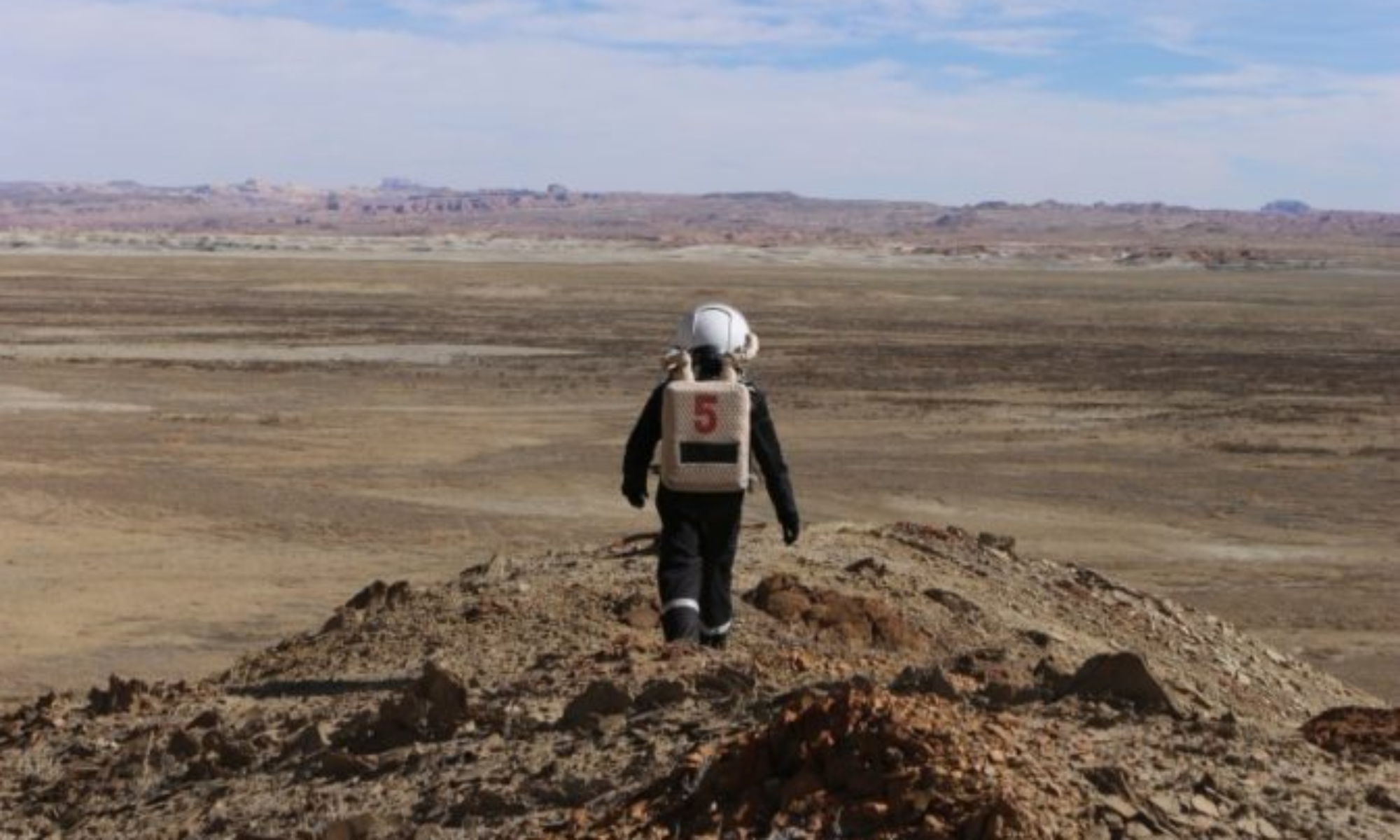
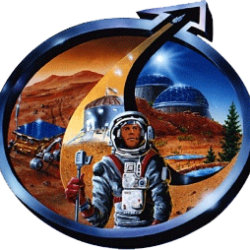
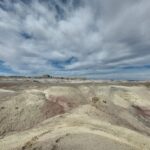

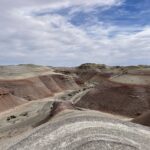
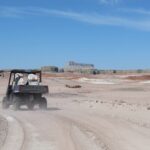
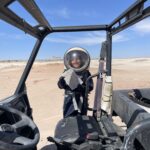


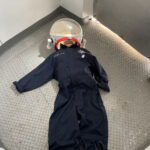

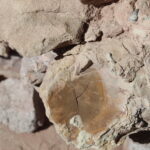
You must be logged in to post a comment.